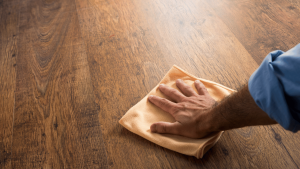- What is Engineered Hardwood Flooring?
- Engineered Hardwood Cleaning Supplies
- Pre-Cleaning Preparation
- Best Cleaner for Engineered Wood Floors
- How to Clean Engineered Wood Floors
- DIY vs. Professional Cleaning Services
- Seasonal Maintenance Tips
- Troubleshooting Common Issues
- How To Maintain and Clean Engineered Hardwood Flooring
- Humidity Levels for Your Hardwood Floor
- Hardwood Floor Protection
- FAQ
Table Of Content
Cleaning engineered wood flooring is simple with our tips. Find daily maintenance, safe cleansers, and high-traffic area protection strategies to keep your floors attractive and durable. Keep floors clean and damage-free.
What is Engineered Hardwood Flooring?

Engineered hardwood flooring combines many layers of wood to replicate the beauty and warmth of conventional hardwood while adding durability and stability. Unlike solid hardwood, engineered hardwood is created from layers of wood veneers connected by heat and pressure.
Layers and Materials
The realistic appearance of high-end engineered hardwood flooring comes from the wear layer, a thin slice of actual hardwood. Oak, maple, or hickory layers enable homeowners to pick their design and provide longevity to the flooring.
Under the wear layer are plywood, HDF, or softwood core layers. Cross-grain stacking and these layers provide a sturdy base that reduces temperature and humidity changes. Engineered hardwood flooring is better for basements and locations with varying moisture levels than solid hardwood because of its security feature.
Engineered hardwood flooring relies on the backing layer, composed of the same material as the core layers, for stability. This multi-layered structure increases durability and prevents solid hardwood warping, cupping, and splitting.
Benefits and Drawbacks
Engineered Hardwood Flooring Benefits
- It is resistant to temperatures and moisture fluctuations, which makes it suited for many situations.
- A multi-layered structure prevents warping, cupping, and cracking.
- Installation Options: Float, glue-down, or nail-down.
- The wear layer is usually pre-finished and ready for usage following installation.
- A variety of wood types and treatments allows customization to complement any décor.
Engineered Hardwood Flooring Cons
- This thinner wear layer can only be sanded and refinished a few times, lowering lifespan in high-traffic areas.
- Costlier than laminate flooring, which may seem identical.
- Lower-quality engineered hardwoods may last less long or look like high-quality ones.
Engineered Hardwood Cleaning Supplies

Engineered hardwood floors require proper maintenance to look their best. Clean without scratching using a soft-bristle broom or microfiber dust mop. A damp microfiber mop is great for everyday cleaning. Avoid ammonia, bleach, and abrasive cleansers that damage finishes—cleaning engineered wood hardwood floors.
A soft cloth and mild cleanser should remove tough spots. Entryways need mats to catch dirt and moisture before they reach the floor. Keep engineered hardwood floors attractive and lasting with regular maintenance and the appropriate materials.
Pre-Cleaning Preparation
Inspecting Your Floor
Check your engineered hardwood flooring before cleaning. Check for dents, scratches, and other damage that may need care. Inspection for loose boards or wear might avoid additional harm while cleaning. Consider fixing any problems before cleaning.
Removing Furniture and Obstacles
Remove all furniture and impediments for a thorough cleaning. This simplifies cleaning and saves floor damage. Avoid dragging furniture on the floor using felt pads or cautious lifting. To clean your whole floor, remove any rugs, mats, or other obstructions.
If you’re looking for high-quality flooring options, be sure to visit our Edmonton flooring store. We offer a wide selection of engineered hardwood flooring that combines durability and beauty for any space.
Best Cleaner for Engineered Wood Floors

Homemade/Natural Engineered Wood Cleaners
Use homemade or natural solutions to clean engineered wood floors safely and effectively. A basic white vinegar-water solution is popular. One part vinegar and ten parts water in a spray container. Mop the floor with a moist microfiber mop after lightly misting. The vinegar removes filth without leaving a trace, and the water dilutes it to maintain the wood finish.
Another alternative is mild dish soap and water. A few drops of soap in a pail of warm water. Always wring out the mop to prevent floor wetness.
How to Clean Engineered Wood Floors
Sweep or Vacuum Daily
Keep engineered wood floors clean by sweeping or vacuuming every day. Remove dust and debris using a soft-bristle broom or hardwood floor attachment-equipped vacuum. This prevents particles from scratching and preserves the floor’s shine.
Avoid Using Harsh Chemicals and Use a pH-Neutral Cleaner
Use a flooring manufacturer-recommended cleaner for thorough cleaning or tough stains. These are designed to remove difficult grime without damaging wood. Read the directions carefully and test a small area to check floor compatibility.
Protect High-Traffic Areas
Entryways and hallways wear out faster. Use rugs or mats to protect these areas from floor contact. Rotate rugs to minimize uneven fading and use non-slip backings to reduce accidents. This easy procedure can extend engineered wood floor life.
DIY vs. Professional Cleaning Services

When to Clean It Yourself
Periodic maintenance of engineered wood flooring is best done yourself. You may sweep or vacuum daily and mop independently with a pH-neutral cleaner. Simple wipe-downs generally remove small spills and stains. DIY floor cleaning saves money and is easy. It’s great for hands-on people who have time for maintenance.
When to Call a Professional
Professional cleaning services are sometimes best. If your floors have severe stains or substantial damage or need a deep clean that your usual routine can’t handle, call the pros. Professionals can repair your flooring without harm using specialized equipment and materials. Buffing, recoating, and mending are all available. If you need to clean or refinish your engineered wood floors, engaging a professional can ensure a good job and prolong its lifespan.
Seasonal Maintenance Tips
Summer Care
- Warping and edema may be prevented by using a dehumidifier.
- To keep floors cool, close blinds or curtains during the warmest portions of the day.
- Summer filth and dust are readily dragged in, so clean floors more regularly.
- Clean up spills quickly to prevent moisture damage.
Winter Care
- Use a humidifier to avoid wood contraction and gaps.
- Cover entryways with mats to capture snow, ice, and salt.
- A moist cloth with a mild cleanser may remove salt stains without harsh chemicals.
- Winter wear and tear may be prevented by periodic cleaning.
Troubleshooting Common Issues
Dealing with Scratches and Scuffs
- Apply a wood repair marker or crayon that matches your floor’s color to minor scratches. Blend by buffing with a soft cloth.
- Rub scuff marks with a soft cloth and a little hardwood cleanser. Baking soda and water may remove tough marks.
- For deeper scratches, use wood filler or hire a professional refinisher.
Addressing Stains and Spills
- To avoid moisture damage, wipe up water spills quickly with a dry towel. After, dry the area fully.
- Use a moist cloth and pH-neutral cleanser to wipe food and drink spills quickly. Avoid soaking the floor.
- For stubborn stains, use a tiny quantity of hardwood floor cleanser and scrub with a soft cloth. If the stain remains, ask an expert about thorough cleaning or refinishing.
How To Maintain and Clean Engineered Hardwood Flooring
Touch Up, Recoat, or Refinish to Fix Major Damage
Touch-Up: For small scratches and scuffs, use wood repair markers, crayons, or floor-color touch-up kits. Apply them to the damaged area and buff them with a soft cloth to match the wood.
Recoat: If your floors are worn but not damaged, recoat. This entails gently sanding and refinishing the floor to restore its shine and prevent damage. Recoating may revive your flooring without refinishing.
Refinish: Deep scratches, dents, and damaged finishes may need refinishing. Sanding the surface removes the damaged layer before applying a fresh finish. Depending on wear layer thickness, engineered hardwood may be refinished once or twice. Ask an expert to evaluate your flooring and provide a solution.
Humidity Levels for Your Hardwood Floor

Radiant Heat Sub-Floor Monitoring & Humidity
Temperature Control: Controlling temperature is essential when utilizing radiant heat with hardwood floors. Wood might bend or gap due to rapid temperature fluctuations. Make sure the temperature is within your flooring type’s recommendations.
Humidity management: With radiant heat, humidity is crucial to hardwood floor durability. Check your home’s humidity using a hygrometer for 30% to 50%. Too much moisture swells wood, while too little shrinks and cracks it.
Sub-Floor Monitoring: Keep a close eye on the subfloor temperature is important when utilizing radiant heat. It should match the hardwood installed. Sudden subfloor temperature variations might affect humidity balance and harm the floor. Regular monitoring keeps temperature and humidity within acceptable limits for hardwood flooring’s lifetime.
Hardwood Floor Protection
Maintaining hardwood flooring’ beauty and longevity requires protection. Stop scratches and dents in high-traffic areas with area rugs and furniture pads. To minimize wood warping and shrinking, maintain 30%–50% indoor humidity. To protect the finish, use pH-neutral, hardwood-specific cleansers. Sweep or vacuum regularly to eliminate scratch-causing dirt. Cover your flooring with drapes or blinds to reduce sunlight. Clean spills immediately to minimize water damage and preserve floor appearance for years.
Frequently Asked Questions
Can I Use a Steam Mop on Engineered Wood? [+]
Steam mopping engineered wood flooring is not advised. Higher heat and moisture from steam may permeate wood layers, warping, swelling, or peeling them. Instead, use a moist microfiber mop with a pH-neutral solution to clean engineered wood floors without damage.
How Often Should I Refinish My Floors? [+]
The thickness of the top wear layer and traffic determines how often engineered wood floors are refinished. Refinishing is required every 10–15 years. However, if your floors exhibit substantial wear, deep scratches, or dullness, refinishing sooner may be necessary. Ask a specialist whether your floors are ready for refinishing.








